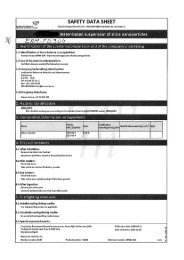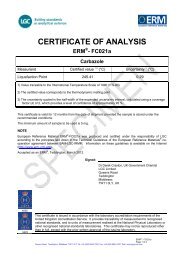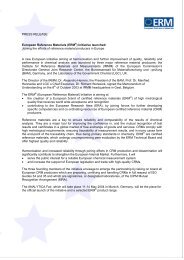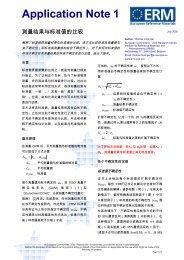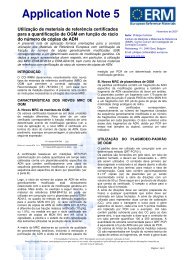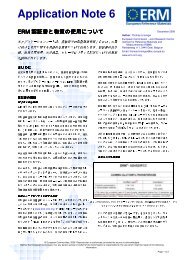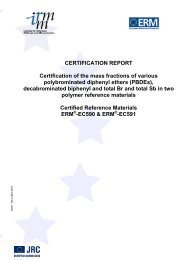English - European Reference Materials
English - European Reference Materials
English - European Reference Materials
You also want an ePaper? Increase the reach of your titles
YUMPU automatically turns print PDFs into web optimized ePapers that Google loves.
Application Note 5<br />
Use of Certified <strong>Reference</strong> <strong>Materials</strong> for<br />
the quantification of GMO in DNA copy<br />
number ratio<br />
This application note provides guidance on the correct use of <strong>European</strong><br />
<strong>Reference</strong> <strong>Materials</strong> certified for their GM (genetically modified) copy<br />
number fraction of a specific GM event. The details given below refer<br />
particularly to the use of the CRMs ERM-BF413d and ERM-AD413 and<br />
the upcoming CRMs certified for copy number ratio.<br />
INTRODUCTION<br />
The JRC-IRMM has recently developed two new<br />
types of GMO Certified <strong>Reference</strong> <strong>Materials</strong><br />
(CRMs) which permit the correct implementation<br />
of the Recommendation (EC) 787/2004 [1] using a<br />
metrologically traceable system. This note gives<br />
instructions on how the new CRMs should be<br />
applied.<br />
CHARACTERISTICS OF THE NEW GMO CRMS<br />
A. New GMO matrix CRMs<br />
The certified values are based on two different<br />
measurement units. Besides a certified value for<br />
the mass fraction of a specific genetic modification<br />
event (see application note 4) the new CRM is<br />
certified for the DNA copy number ratio. This<br />
parameter, expressed in %, is calculated<br />
according to:<br />
GM DNA copy number [cp]<br />
DNA copy number ratio [%] = x 100<br />
Target taxon-specific DNA copy number [cp]<br />
The certification is based on QRT-PCR<br />
(quantitative real-time PCR) measurements.<br />
These measurements are calibrated by using a<br />
dedicated plasmid DNA calibrant that is certified<br />
to contain one copy of both the GM and the taxonspecific<br />
target sequence per plasmid (see part B).<br />
Therefore, the GM maize DNA copy number ratio<br />
is directly related to the GM event analysed.<br />
Moreover, in the example below, the CRM ERM-<br />
BF413d should only be used in conjunction with<br />
the plasmid calibrant ERM-AD413 and the eventspecific<br />
MON 810 detection method [2]. The<br />
certified MON 810 DNA copy number ratio<br />
(0.57 %) is different from the certified mass<br />
fraction (10.0 g/kg or 1.0 %) as the certified MON<br />
810 copy number ratio takes into account the<br />
zygosity, ploidy and endoreduplication status of<br />
the seeds used to produce this material.<br />
The matrix CRM is intended for the quality control<br />
of analytical procedures including the DNA<br />
extraction and purification as well as the PCR<br />
measurement steps for a particular GM event.<br />
B. New GMO plasmid CRMs<br />
Author: Philippe Corbisier<br />
The certified calibrants contain a defined DNA<br />
fragment specific for a genetic modification as well<br />
as a defined DNA fragment specific for the taxon<br />
analysed. That plasmid contains a 170 base pair<br />
(bp) fragment of the MON 810 5' plant-P35S<br />
junction and a 351 bp fragment of the maize<br />
endogenous high mobility group gene (hmg).<br />
The certified values are the number of cloned GM<br />
and the number of taxon-specific DNA fragment<br />
per plasmid respectively. The number ratio<br />
between those two DNA fragments is provided as<br />
an indicative value obtained by duplex and<br />
simplex real-time PCR.<br />
USE OF THE GMO PLASMID CALIBRANT<br />
The calibrant has to be used in conjunction with a<br />
defined QRT-PCR method [1].<br />
Each calibrant is delivered on dry-ice in a closed<br />
plastic tube and should be kept at -20 °C until<br />
use. The contents should be first thawed, then<br />
mixed and finally opened and diluted under a<br />
laminar flow to reduce the risk of contamination.<br />
Each tube contains approximately 2 x 10 6 copies<br />
(cp) of plasmid per µL and the recommended<br />
starting volume for the dilution series is 50 µL.<br />
The dilution protocol stated on the certificate<br />
should be followed. The dilution buffer is not<br />
provided.<br />
The dilution series should always be prepared<br />
fresh and any excess discarded in closed tubes.<br />
The dilution series is used to prepare two<br />
calibration curves (CCs) (one CC for the<br />
transgene and one CC for the taxon-specific<br />
gene) each having 5 points, each point measured<br />
in triplicate in the PCR reaction (see example).<br />
One tube provides enough calibrant to prepare 10<br />
CCs for both targets which means that a total<br />
number of 100 to 250 samples can be quantified<br />
with one tube. The recommended sample intake<br />
for QRT-PCR is 5 µL of template DNA per PCR<br />
well.<br />
Measured fluorescence threshold values (Ct<br />
values) must be plotted against the theoretical<br />
number of copies of both fragments to generate<br />
two CCs. These CCs are used for the<br />
Page 1 of 2<br />
November 2007<br />
<strong>European</strong> Commission - Joint Research Centre<br />
Institute for <strong>Reference</strong> <strong>Materials</strong> and<br />
Measurements (IRMM)<br />
Retieseweg 111, 2440 Geel, Belgium<br />
Email: philippe.corbisier@ec.europa.eu<br />
www.erm-crm.org<br />
© <strong>European</strong> Communities, 2007. Reproduction is authorised, provided the source is acknowledged.<br />
Neither the <strong>European</strong> Commission nor any person acting on behalf of the Commission is responsible for the use which might be made<br />
of the information given in this application note.
quantification of the GM target relative to the<br />
taxon-specific target in an unknown sample. The<br />
results can then be calculated as the ratio of both<br />
targets and expressed in percentage according to<br />
the Recommendation (EC) 787/2004. An internal<br />
quality control (QC) PCR can be made by<br />
calculating the average ratio of measured Ct<br />
EXAMPLE<br />
Genomic DNA extracted from an unknown sample and from<br />
ERM-BF413d used as QC material are analysed by QRT-PCR<br />
using ERM-AD413 as calibrant. Ct values are obtained for the<br />
ERM-AD413 calibrant after amplification of the hmg and MON<br />
810 fragments (Table 1). Average Ct values for the unknown<br />
sample, 32.76 and 25.44 are obtained for the amplification of<br />
MON 810 and hmg fragments, respectively. For the QC<br />
material, average Ct values of 31.22 and 22.20 are obtained<br />
for the MON 810 and hmg fragments, respectively.<br />
The slopes and Y-intercepts of the two calibration curves must<br />
be determined to calculate the MON 810 content in both samples<br />
assuming a straight line as the best-fit model function. The<br />
built-in modules of Microsoft®Excel or any other available<br />
calibration/determination software can be used to calculate the<br />
slopes and Y-intercepts.<br />
values for the taxon-specific and transgenic<br />
targets for the calibration points corresponding to<br />
2000 cp/µL. That ratio should be in agreement<br />
with 1.04 % (expanded uncertainty 0.06 %) for a<br />
simplex PCR as indicated in the certification<br />
report (see also ERM Application Note 1).<br />
The slopes (b) of both linear regression lines can be calculated using the formula: ∑ ( log( x)<br />
− log( x)<br />
)( y − y)<br />
b = 2<br />
∑ ( log( x)<br />
− log( x)<br />
)<br />
where, x<br />
represents the number of copies of the fragment amplified and y represents the corresponding Ct value. The slopes of<br />
the calibration curves of the hmg and the MON 810 fragments given in Table 1 are respectively -3.25 and -3.32. The Yintercepts<br />
(a) of the regression lines are calculated using the formula: a = y − bx<br />
when log (x) =0. In our example, the<br />
a-values for the hmg and MON 810 regression lines are 39.26 and 40.93, respectively. Those values represent the<br />
theoretical Ct values corresponding to 1 cp of both fragments. The slope serves to calculate the PCR efficiency (ε) with<br />
the formula: ε = (10 -1/b -1)*100. In our example, the PCR efficiencies were equal to 99.7 % and 103.1 % for the<br />
amplification of the MON 810 and hmg fragments, respectively. The number of MON 810 copies (cp) present in the<br />
unknown sample is calculated as:<br />
cp<br />
MON810<br />
= 10<br />
⎛ Ct MON 810 −a<br />
MON 810 ⎞<br />
⎜<br />
⎟<br />
⎝ bMON<br />
810 ⎠<br />
, where CtMON810, aMON810 and bMON810 are the Ct values,<br />
the Y-intercept and the slope obtained for MON 810 amplification. The same calculation is done to determine the<br />
⎛ Cthmg<br />
−a<br />
hmg ⎞<br />
⎜<br />
⎟<br />
⎜ b ⎟<br />
number of copies of the hmg fragment with the formula:<br />
⎝ hmg ⎠<br />
cp = 10 . In our example, the estimated average<br />
copy numbers of MON810 and hmg fragments present in the unknown sample is 289 and 17878 cp, respectively. The<br />
MON 810 content of the unknown sample expressed in percentage is therefore equal to: 289 cp MON 810<br />
* 100 = 1.<br />
62<br />
. The<br />
%<br />
17878 cp<br />
same calculation is made for the QC material containing: 841 cp MON 810<br />
* 100 = 0.<br />
47<br />
of MON 810. Taking into account the<br />
%<br />
177513 cp<br />
uncertainty associated with the ERM-BF413d and the uncertainty of the measurement (see ERM Application Note 1), it<br />
can be verified if the measured value agrees with the certified values of ERM-BF413d. In the example given above the<br />
ratio of the average Ct values of 1.05 obtained for 10000 cp (5 µL of ERM-AD413 at 2000 cp/µL) is in agreement with<br />
the indicative value of 1.04 ± 0.06 reported on the ERM-AD413 certificate, meaning that this GM quantification was<br />
under control.<br />
[1] <strong>European</strong> Commission Recommendation (EC) N° 787/2004 of 4.10.2004 on technical guidance for sampling and detection of<br />
genetically modified organisms and material produced from genetically modified organisms as or in products in the context of<br />
Regulation (EC) No 1830/2003. Off. J. Eur. Union L 348 (2004) 18-26<br />
[2] ISO 21570:2005 Foodstuffs - Methods of analysis for the detection of genetically modified organisms and derived products -<br />
Quantitative nucleic based methods. Annex D2 Event-specific method for the relative quantitation of maize line MON 810 DNA using<br />
real-time PCR. 93-99.<br />
___________<br />
1 Cross-contamination or unspecific amplification should be suspected if the Ct values for the NTC differs form the number of PCR<br />
cycles performed.<br />
hmg<br />
hmg<br />
Total number of cp of the<br />
MON 810 fragment Ct values measured average<br />
replicate 1 replicate 2 replicate 3 Ct<br />
50000 25.30 25.19 25.15 25.21<br />
10000 27.57 27.62 27.66 27.62<br />
1000 31.19 30.89 31.14 31.07<br />
100 33.99 35.12 34.80 34.64<br />
25 35.79 35.67 36.37 35.95<br />
NTC 45.00 45.00 45.00 45.00<br />
Total number of cp of<br />
the hmg fragment<br />
500000 20.76 20.67 20.63 20.69<br />
100000 22.92 23.00 23.04 22.99<br />
10000 26.39 26.36 26.33 26.36<br />
5000 27.31 27.29 27.37 27.32<br />
1000 29.38 29.19 29.57 29.38<br />
NTC 45.00 45.00 45.00 45.00<br />
Table 1: Example of experimental Ct values obtained using<br />
the ERM-AD413 as calibrant. NTC 1 = no template control.<br />
hmg<br />
Page 2 of 2



